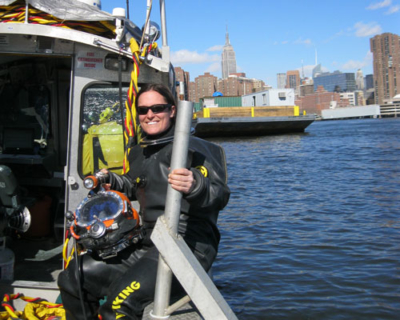 Danielle Somma ’06 makes her living under water
Danielle Somma ’06 makes her living under water
Under water for hours at a time, Danielle Somma ’06 keeps tabs on marine infrastructure in the New York City area as an engineer diver. It’s dark. It’s cold. And she loves it.
Interviewed by David Svenson
Edited by Alanna Conn
Photos by Robert Snelgrove
How did you get from studying on the shore of Sebago Lake to making a living under water?
I started at Saint Joseph’s as a mathematics and secondary education major. When the College introduced the pre-engineering program my sophomore year, I decided to change my major. It was a three-plus-two transfer agreement with Manhattan College—three years at SJC and two years at Manhattan.
I was the first person to go through it. It was a little nerve-racking to know I was the first person. I didn’t know what to expect and whether I’d make it or how well I’d do. But I set my mind to it. I took it one step at a time and figured it out along the way.
I graduated with mathematics and pre-engineering degrees, and then I graduated from Manhattan College with a civil engineering degree in 2008. Now I’m studying to take the Professional Engineering License exam. It warrants nearly 300 hours of study.
Did you know all along that you’d become an engineer diver?
Actually, I had never dove before. I went to a career fair my last year at Manhattan College, and there was this guy standing there with a dive hat. I thought, “Now that looks cool.” I went up to him and he told me what he did—it was engineering but on the coastal marine side. I grew up in Maine, always near the ocean. I knew for a fact that I wouldn’t be landlocked with a job like that.
I got a job right out of college with a firm in New York City, and they put me through SCUBA training. Eventually I got a job with Ocean and Coastal Consultants (OCC), the company I currently work for as an engineer diver. OCC sent me to commercial dive school out in Minnesota to become trained as a surface-supplied diver.
What type of work are you responsible for at Ocean and Coastal Consultants?
As an engineer diver, I’m involved in so much. I’m not pigeonholed—I do both underwater and topside (or above water) inspections.
For underwater inspections, we typically do either rapid emergency inspections or routine inspections. We had a lot of rapid emergency inspections after Hurricane Sandy. We were out there making sure clients’ structures were cleared to keep using.
Routine inspections normally occur every three to five years. From the collected data, we’ll create a report that assigns a condition rating to the structure and outlines repairs or maintenance the client can do to prolong the structure’s life.
Who are your clients?
We work with anyone from private clients who have a house on the water and need a seawall inspected, to projects for large, liquid product terminals. The structures we typically work with are seawalls and steel bulkheads, both of which hold back fill. We also inspect piers. Piers usually consist of timber, steel, and concrete piles. The project I am currently involved with is the rehabilitation of the timber piles on FDR Drive for the NYC Department of Transportation.
Is there a normal day?
I usually meet the guys at 5:30 in the morning to pick up the boat at the marina. It takes us about an hour to get to the site. Then we tie up the boat, go over the plans for the day, and get dressed to dive.
When we dive, we never stay at one depth. We’re constantly moving up and down the structure. It’s a workout, especially when there’s a high current. Recently I did a dive and the current was around two knots. It doesn’t look like much topside, but when you get in the water it’s just ripping.
It can be relaxing, though. It depends on what you need to do—it’s a lot more relaxing in the summertime. In the cold, the dry suit is like wearing a big rubber bag. It’s hard to move around in. But I like it. It’s better than sitting behind a desk all day.
Does that mean you’re under water for a large portion of the day?
The longest I’ve done was between three to three and a half hours. Typically we’re in there for two hours or so. There are many factors that affect that.
But there’s a lot to the day. We put in almost eight hours or so just doing the inspection. There’s not really time to go back to the office. You go home and plan for the next day. It’s after the whole inspection that you start incorporating the data into a report that you can give to your client.
What kind of gear do you have with you?
With surface-supplied diving, which is what we do, the diver’s air supply is pumped through a hose to the diver from the surface by a compressor. Other hoses and cables are attached to the diver including a communications wire, a depth-sensing hose, and a video line. The bundle of hoses is called the diver’s umbilical. Unlike SCUBA, you have an unlimited supply of air, and an emergency air supply provided by the bailout tank on the diver and two high-pressure bottles topside. The redundancy in air supply and constant communications with the topside crew makes surface-supplied diving much safer than SCUBA diving. I always have my dive knife. I wear fins, too, to move about the structure.
Some of the tools we typically use are folding rulers, pick hammers, calibers to measure diameter of piles, and non-destructive testing equipment, such as an ultrasonic surface thickness gauge to measure the thickness of steel elements, so we can tell how much they have deteriorated.
You’ve described the job as both relaxing and challenging. Is it ever scary?
I was nervous on my first inspection—nervous about what I was going to find under water. There’s that weird fear of the unknown. And when you’re diving in NYC, there’s such low visibility. You can only see six inches to a foot in front of you. Sometimes things jump out at you. You’ll see a crab or a fish. It’s startling when they come out of nowhere.
Also, it’s dangerous. It’s very dangerous. You can’t be claustrophobic under water. The light on your helmet might go out in a very confined area. Sometimes you can feel the fear creeping over you, but you have to just focus on your task. When I first started diving, I was much more vulnerable to that kind of stuff. But now it’s just an everyday thing. Get in the water, do some inspections.


